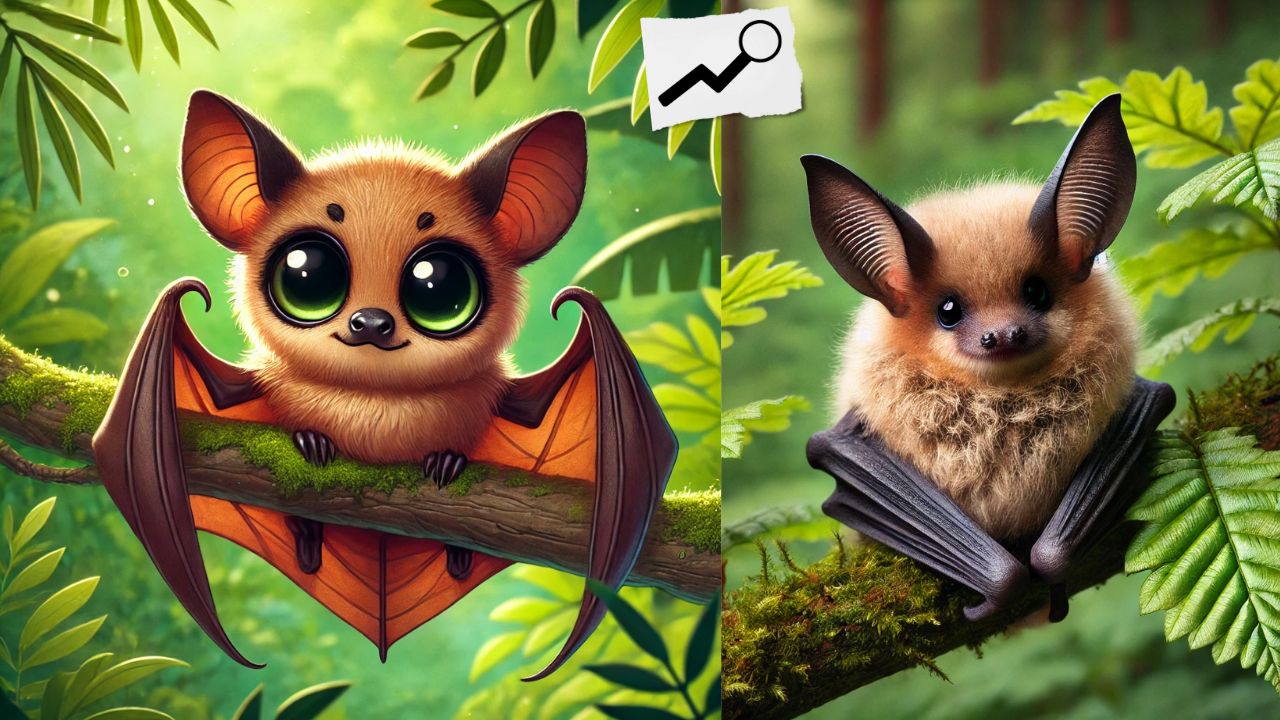Bats often get a bad rap, commonly associated with spooky tales and nocturnal nuisances. However, there’s a lot more to these fascinating creatures, especially when it comes to “cute:-_noi7qvbwi= bats”. These bats not only play crucial roles in their ecosystems but also possess charming characteristics that make them truly endearing. This article aims to shed light on the world of “cute:-_noi7qvbwi= bats”, exploring their habitats, behaviors, and the importance of their conservation.
What Are “cute:-_noi7qvbwi= bats”?
“cute:-_noi7qvbwi= bats” refer to bat species that exhibit particularly charming and appealing traits. These bats often have features such as large, expressive eyes, small and delicate frames, and behaviors that make them fascinating to observe. Unlike their often misunderstood reputation, these bats can be incredibly endearing and are crucial to the health of many ecosystems.
Characteristics that Make Them Cute
The features that classify these bats as “cute” include:
- Large, Expressive Eyes: Many species have disproportionately large eyes that give them a charming, almost cartoonish appearance.
- Small and Delicate Frames: Their petite size and delicate features add to their appeal.
- Unique Fur Colors: Some species, like the Honduran White Bat, have strikingly unique fur colors that make them stand out.
- Friendly Behavior: These bats often exhibit behaviors that seem curious or friendly towards humans and other animals.
Examples of “cute:-_noi7qvbwi= bats”
Honduran White Bat:
- Known for its bright white fur and leaf-shaped nose, this bat is often found in the rainforests of Central America. Its unique coloration makes it one of the most recognizable “cute:-_noi7qvbwi= bats.”
Fruit Bats:
- Also known as flying foxes, these bats have large eyes and faces resembling small dogs. They are found in tropical and subtropical regions and are crucial for pollination and seed dispersal.
Northern Long-eared Bat:
- This small bat is known for its gentle demeanor and long ears. It is native to North America and plays a vital role in controlling insect populations.
Table: Comparison of Cute Bat Species
| Species | Unique Feature | Habitat | Diet |
|---|---|---|---|
| Honduran White Bat | Bright white fur | Central American rainforests | Fruits, insects |
| Fruit Bat | Large, dog-like eyes | Tropical/subtropical regions | Fruits, nectar |
| Northern Long-eared Bat | Long ears, gentle demeanor | North America | Insects |

Next Section: Types and Physical Characteristics
Types and Physical Characteristics
Different types of “cute:-_noi7qvbwi= bats“ can be found across the globe, each with unique physical traits. Understanding these characteristics helps us appreciate their diversity and significance.
Honduran White Bat:
- Physical Traits: Small size, bright white fur, distinctive leaf-shaped nose.
- Habitat: Rainforests of Central America.
- Diet: Primarily fruits, supplemented by insects.
Pallid Bat:
- Physical Traits: Pale coloration, large ears, friendly appearance.
- Habitat: Deserts and arid regions of North America.
- Diet: Insects, scorpions, occasionally small vertebrates.
Flying Foxes:
- Physical Traits: Large wingspan, gentle face resembling a small dog.
- Habitat: Tropical and subtropical regions.
- Diet: Fruits, nectar.
These bats are often small, have large, expressive eyes, and display behaviors that endear them to observers, contributing to their “cute” factor. Their physical characteristics not only make them appealing but also aid in their survival and ecological roles.
The Habitat of “cute:-_noi7qvbwi= bats”
The habitats of “cute:-_noi7qvbwi= bats” are diverse, spanning various geographic regions and environmental conditions. Understanding their habitats is crucial for their conservation and protection.
Where Do “cute:-_noi7qvbwi= bats” Live?
Tropical Rainforests:
- Example: Honduran White Bat
- Characteristics: These dense, lush forests provide ample roosting spots and a rich supply of fruits and insects. The canopy cover and abundant vegetation offer protection and a stable environment for these bats.
Caves and Caverns:
- Example: Northern Long-eared Bat
- Characteristics: Caves and caverns provide a safe and stable environment for bats to roost. These locations offer shelter from predators and harsh weather conditions, making them ideal habitats for many bat species.
Urban Areas:
- Example: Some Fruit Bats
- Characteristics: Urban areas, surprisingly, can be hospitable to bats. They may roost in buildings, bridges, or other man-made structures. These adaptable species can find food in gardens, parks, and other green spaces within cities.
Types of Environments They Thrive In
Forests and Woodlands:
- Forests provide a rich ecosystem with plenty of food sources and roosting sites. Bats in these environments play significant roles in pollination and seed dispersal.
Wetlands:
- Wetlands offer a unique habitat with abundant insect life, which is a primary food source for many insectivorous bats. The presence of water bodies also attracts numerous bat species.
Deserts:
- Some species, like the Pallid Bat, are adapted to arid environments. They have specialized behaviors and diets that allow them to thrive in these harsh conditions.
Geographic Distribution
The distribution of “cute:-_noi7qvbwi= bats” varies widely depending on the species:
- Honduran White Bat: Found primarily in Central American rainforests.
- Pallid Bat: Native to the deserts and arid regions of North America.
- Fruit Bats: Widespread across tropical and subtropical regions, including Africa, Asia, and the Pacific Islands.
Understanding the geographic distribution of these bats is essential for conservation efforts. Protecting their habitats in these regions ensures their survival and the health of the ecosystems they support.
Next Section: Behavior and Diet of “cute:-_noi7qvbwi= bats”
Behavior and Diet of “cute:-_noi7qvbwi= bats”
The behavior and diet of “cute:-_noi7qvbwi= bats” are as fascinating as their physical characteristics. Their activities and eating habits are integral to their role in the ecosystem.
Nocturnal Activity:
- Most bats, including the “cute:-_noi7qvbwi= bats,” are nocturnal. They are active at night, which helps them avoid predators and exploit nocturnal food sources. Their night-time activity is supported by their exceptional navigation skills, primarily through echolocation.
Echolocation:
- Bats use echolocation to navigate and find food in the dark. This sophisticated biological sonar involves emitting high-frequency sounds that bounce off objects, allowing bats to “see” their surroundings through sound.
Diet:
- Fruit Bats: Primarily consume fruits and nectar. They play a crucial role in pollination and seed dispersal.
- Insectivorous Bats: Eat insects, contributing to pest control. For example, the Northern Long-eared Bat feeds on moths, beetles, and other insects.
- Omnivorous Bats: Some species have a varied diet that includes fruits, insects, and small animals.
Frequently Asked Questions (FAQs) About “cute:-_noi7qvbwi= bats”
Q1: What makes a bat “cute”?
A: Bats are considered “cute” when they have features like large, expressive eyes, small and delicate frames, unique fur colors, and friendly behaviors. Examples include the Honduran White Bat with its bright white fur and the Fruit Bat with its dog-like face.
Q2: Where can I find “cute:-_noi7qvbwi= bats”?
A: These bats can be found in various habitats, including tropical rainforests, caves, and urban areas. They are geographically distributed across regions such as Central America, North America, and tropical/subtropical regions worldwide.
Q3: What do “cute:-_noi7qvbwi= bats” eat?
A: The diet of these bats varies by species. Fruit Bats primarily eat fruits and nectar, while insectivorous bats consume insects. Some omnivorous species have a varied diet that includes fruits, insects, and small animals.
Q4: Why are “cute:-_noi7qvbwi= bats” important to the ecosystem?
A: These bats play crucial roles in their ecosystems, including pollination, seed dispersal, and pest control. By aiding in plant reproduction and controlling insect populations, they help maintain ecological balance.
Q5: How can I help in the conservation of “cute:-_noi7qvbwi= bats”?
A: You can support bat conservation efforts by creating bat-friendly habitats, protecting their natural roosting sites, and supporting conservation organizations through donations or volunteer work. Raising awareness about the importance of bats also contributes to their protection.
Conclusion
“cute:-_noi7qvbwi= bats” are not only endearing but also vital to the health of our ecosystems. Their roles in pollination, seed dispersal, and pest control highlight their ecological importance. By understanding and appreciating these charming creatures, we can contribute to their conservation and ensure they continue to thrive. Supporting efforts to protect their habitats and raise awareness about their significance can make a significant difference. Let’s celebrate and protect the “cute:-_noi7qvbwi= bats” that make our world a richer and more vibrant place.






